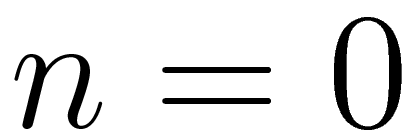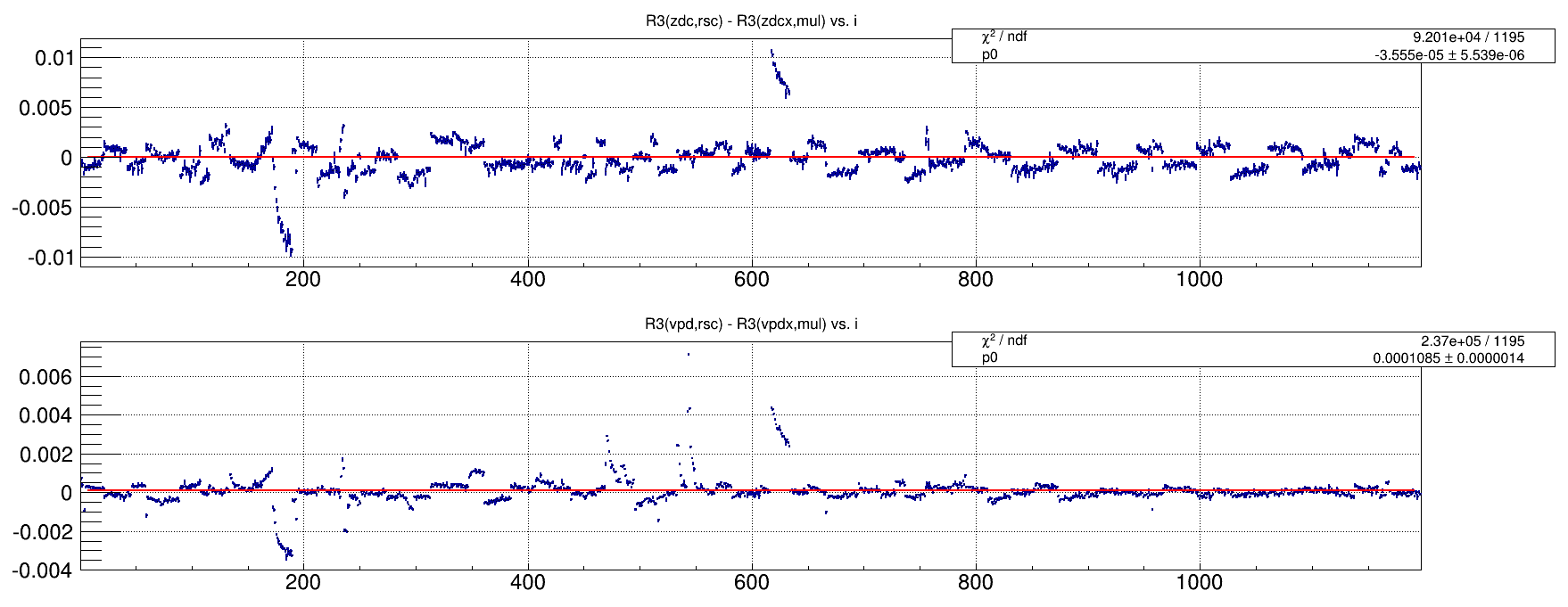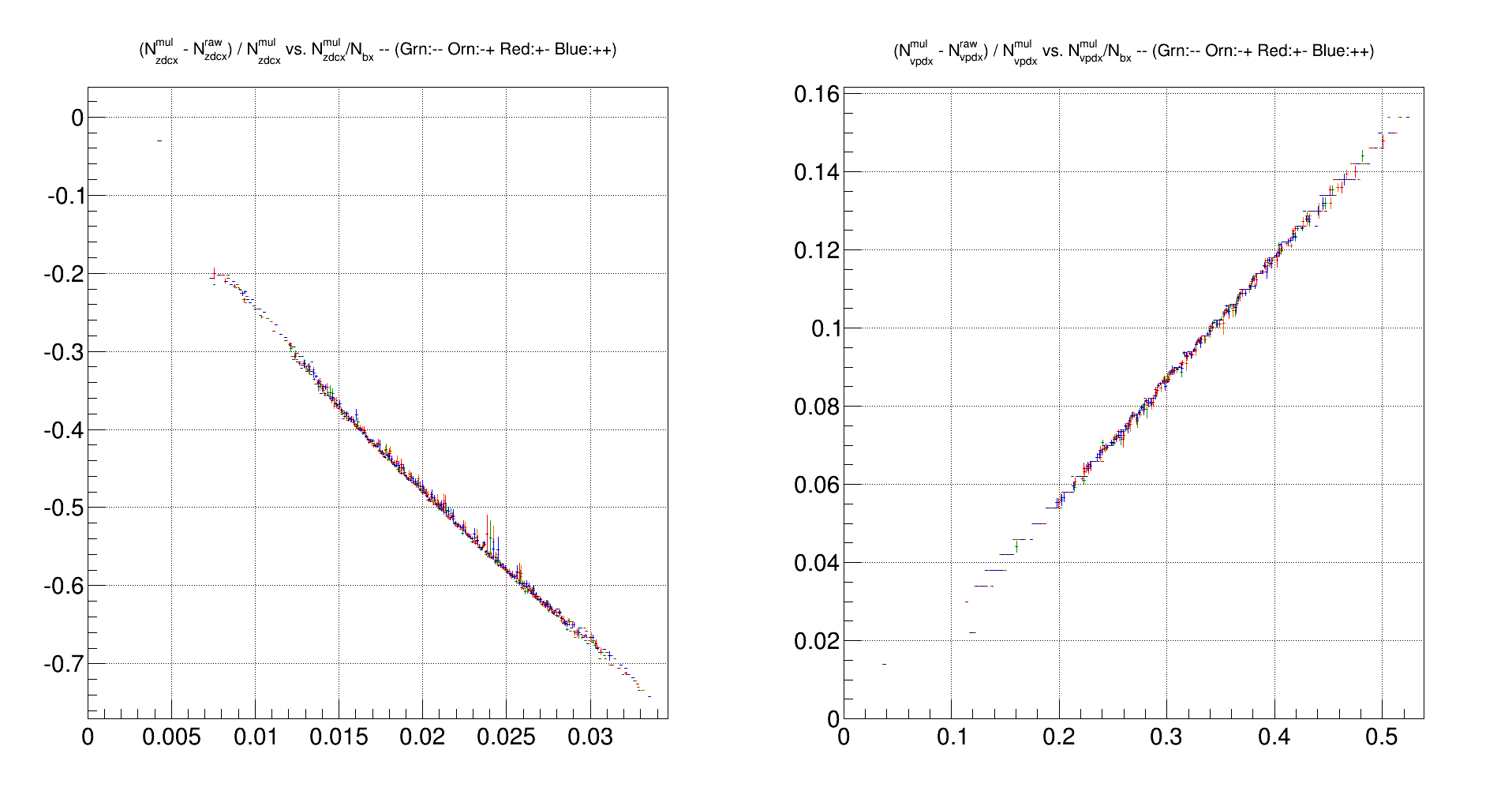Rate-safe Counting for Relative Luminosity
I have begun considering the "rate-safe counting" method for computing the relative luminosities, using techniques from Andrew Manion's work on the PHENIX relative luminosity. His methods are documented in section 4.3 of his thesis (https://www.phenix.bnl.gov/phenix/WWW/publish/manion/Manion_Thesis.pdf). He also wrote a PHENIX analysis note, which has been attached to this blog entry (https://drupal.star.bnl.gov/STAR/system/files/manion_analysis_note.pdf)
Manion's Rate-Safe Counting Technique
Two Event Classes:
- Double-sided events (DS) -- collisions which will trigger a coincidence
- DS events occur an average of λ times per bXing
- Single-sided events (SS) -- collisions which will trigger a single but not a coincidence
- East SS events (ESS) occur an average of λE times per bXing
- West SS events (WSS) occur an average of λW times ber bXing
- East SS events (ESS) occur an average of λE times per bXing
Probability for detecting kE hits in E-scaler from DS events, given that E-scaler has efficiency * acceptence = εE:


Probability for detecting kW hits in W-scaler from DS events, given that W-scaler has efficiency * acceptence = εW:


The joint probability that the E-scaler detects kE hits AND the W-scaler detects kW hits from DS events is
![]()

where PDS(kW|kE) is the probability that the W-scaler detected kW hits given that the E-scaler detected kE hits.
Let i denote the number of collisions.
After a bit of effort (see references to Manion's papers above), one can show that this joint probability distribution may be written:


Now consider SS events.
Probability for detecting kE hits in E-scaler from SS events:


Probability for detecting kW hits in W-scaler from SS events:


Consider the following three probability distributions:
1. zero hits in E-scaler:
![]()

2. zero hits in W-scaler:
![]()

3. zero hits in 2-sided detector:

![]()
Let P* denote the probability that the 2-sided detecter detects zero hits in both E & W, given the condition that the single sided detectors each detected zero hits.
Using the Kolmogorov definition of conditional probability, P* is expressed as


Let PE(W) be the probability of detecting at least 1 E(W)-scaler singles, and PEW the probability of detecting at least 1 coincidence. These probabilites are used
to rewrite the above three probability distributions for seeing zero hits in the form of "(probability of zero hits) = 1 - (probability of at least 1 hit)".
Take the logarithm of P* to obtain


Assume the probability distributions of detecting NE(W) hits in the E(W)-scaler and NEW coincidences are all binomial, given Nbx bXings.
Manion argues this is needed since the probability of a trigger is significant for all filled bXings. Denoting the mean of these binomial distributions by <.>, we thus have


Finally, the product of E&W acceptances & efficincies times the rate-safe counts is written in terms of raw scaler counts {NE,NW,NEW} as:

 <===== rate-safe correction equation
<===== rate-safe correction equation
where the subscript "rsc" stands for (rate-safe correction)
Note on Accidentals
- For bXings with 1 collision, we either have a true coincidence from a DS-event or a single hit from a SS-event
- No accidental coincidences occur in this case
- No accidental coincidences occur in this case
- For bXings with more than 1 collisions, we have the following possibilities
- Detection of coincidence event: either one or both of the following cases must occur
- At least 1 DS-collision -- occurs an average λ times per bXing
- At least 1 ESS-collision and 1 WSS-collision -- occurs an average λE and λW times per bXing, respectively
- Detection of single event
- DS-event contribution
- All SS events in the bXing are toward one detector -- occurs an average λE or λW times per bXing
- Detection of coincidence event: either one or both of the following cases must occur
Claim: P* only depends on λ, but not on λE or λW. Thus the above quantity Nrsc only counts "true coincidences"
Run 13 Relative Luminosity Impact
The rate-safe technique is implemented in the relative luminosity by using Nrsc, assuming the Ω factors are independent of initial spin
Important Note: the rate-safe error bars are currently not being propagated as done in Manion's papers. I am currently using the error bars which come from sqrt(counts), which is the
same uncertainty propagation used in the acc+mul corrections case.
The relative luminosity computed using the previous multiples+accidentals corrections differs at the 0.1% level from that using the rate-safe method;
The plots below show the difference between rate-safe ZDC and mul+acc corrected ZDCX as well as that for the VPD:

The rate safe technique improves the comparison between R3 computed using the ZDC vs. VPD by a factor of 2; this factor of 2 improvement is also seen
for other relative luminosities R1,R2,R4-9. The pair of plots below show the R3 value for ZDC minus VPD using old corrections method first and then rate-safe method second:

The following plots show the fraction of counts which undergo acc+mul corrections, plotted vs. acc+mul corrected count probability for the ZDC (left) and VPD (right)

Then compare these plots to similar plots using the rate-safe counting method (note the Ω factors!)
Conclusion: the fraction of "undercounting" or "overcounting" is much less dependent on hit probability when using the rate-safe method
[n.b. the stepping structure in these plots is correctable by using finer binning; different colours are for different initial spin states]

The rate-safe method also impacts the scaler ALL, determined using the bunch fitting technique
First, the distribution of scaler ZDCX ALL w.r.t. VPDX using the acc+mul corrections is
.png)
The widths of the Gaussians are:
- left sigma = 0.001080
- right sigma = 0.000979
Comapare this to the same distribution, but using rate-safe corrections:
.png)
The widths of the Gaussians are:
- sigma left = 0.000418
- sigma right = 0.000457
The narrower distributions using the rate-safe method may cause a drop in the Run 13 ALL systematic uncertainty by a factor of 2-3
The spin pattern correlation remains evident, however.
- dilks's blog
- Login or register to post comments
